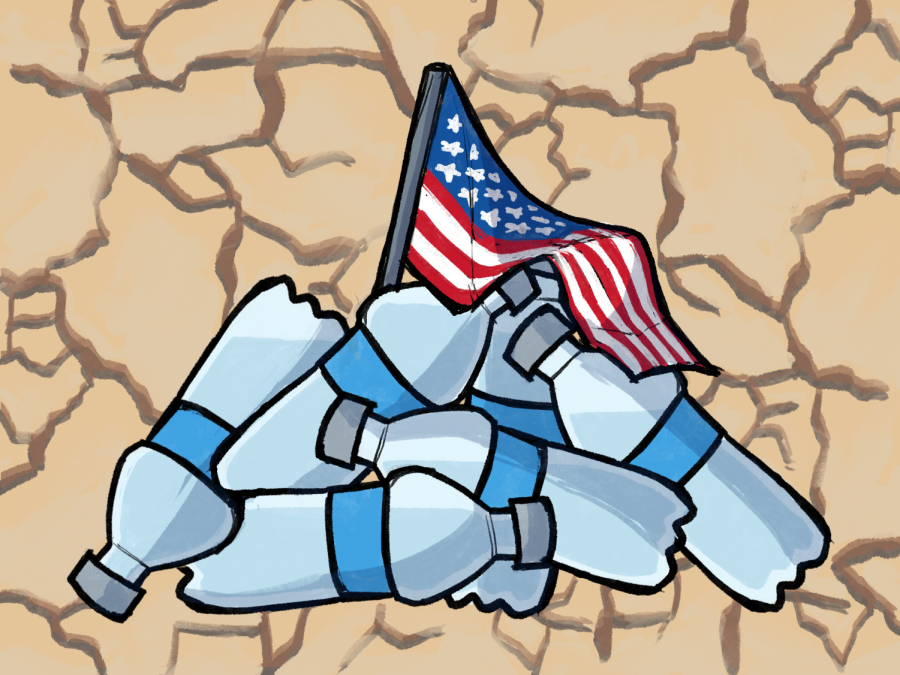OPINION: Water scarcity poses a threat to America
Water scarcity in the United States creates challenges for American health and economy.
Water is a vital resource for all Americans. In recent decades, however, the U.S.’s supply of clean water has continued to deplete significantly. According to the Environmental Protection Agency, Americans consistently use an approximate 82 gallons of water per day, with the average American family anually spending more than $1,000 on water costs and wasting up to 180 gallons per month. Considering American’s abundant usage of water, a lack of access to clean water has caused devastating effects on the U.S.’s health, economy and energy sources.
America’s contaminated water, often caused by poor infrastructure, has led many undeserving citizens to face detrimental health effects. Carelessness in water quality has resulted in the annual illness of roughly 7.2 million Americans. According to earth911.com, water can be polluted by runoff from agricultural sites, which can lead to metals, chemicals and animal waste contaminating local water. In urban areas, leaking sewers can pollute drinking water while outdated designs, such as rusting pipes, can lead to heavy metal contaminating the water.
The Flint, Michigan water crisis demonstrates the severity of contaminated water as residents were forced to use bottled water for daily chores in fear of the lead-infested water. The crisis in Michigan revealed cases of Alzheimer’s disease, lowered IQ and Legionnaires’ disease, which had infected 87 people and killed 12. The health risks concerning the U.S.’s water supply are serious and demand government action as people continue to suffer.
America’s water crisis has not only caused individuals hardships but also the economy as a whole. According to an article by spotlightonpoverty.org, an average U.S. household is expected to spend around $1,350 per year on plastic bottled water, costing the American economy roughly $8.58 billion every year and leaving the problem of water contamination unaddressed. As people grow more desperate, the demand for water increases and many are relying on bottled water as a safe alternative.
Without any permanent solution, the economy and environment will suffer more. The lack of investments into new water technology displays how the water crisis is not being addressed by the government nor truly cared about by the public. Money is continuously being drained from the economy to sustain ineffective and temporary solutions, and clean water scarcity continues to remain a dire problem to American health.
As a result of clean water scarcity, frequent power shortages are occurring throughout America. The World Resources Institute reported that hydropower and thermoelectric power make up 98% of the world’s electricity generation. Both of these sources are water-intensive, making them vulnerable to malfunction due to water shortages. With two of America’s largest reservoirs, Lake Mead and Lake Powell, on the brink of drying out, power outages are becoming more frequent.
One vital hydroelectric power plant in Lake Oroville, California was shut down on Aug. 5, 2022, causing major blackouts across the state and adding to the state’s endeavors against the ongoing drought. Electricity remains an important resource in the lives of all Americans and is used in many daily activities including cooking, driving and HVAC systems. With modern appliances becoming restricted for Americans, many struggle to comfortably function through their daily lives and maintain good health.
Ultimately, the problem of the water shortages stems from the outdated water technology currently used in America, and there are a multitude of faults in America’s current water system. The water often does not reach certain places due to it being restricted to old pumps and pipes, with water from old pipes being especially vulnerable to contamination as the system itself is not properly sanitized. In comparison to other countries with highly sophisticated water filtration systems, America has proven to be severely behind, and with the consequences becoming more apparent, America must now strive to resolve their water problem.
One viable solution being considered is the water reuse technologies under development by the U.S. Department of Agriculture and the EPA. They plan to develop a system to combat droughts and diversify water reserves. These efforts could one day help keep water abundant and clean in America, which is ideal for the future of the country’s citizens and economy.
















